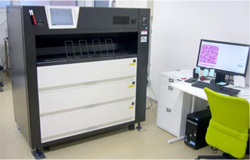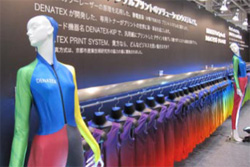Home > Highlighting JAPAN > Highlighting Japan NOVEMBER 2012 > Toward Zero Emission Fabric Printing
Highlighting JAPAN
[SERIES] SCIENCE & TECHNOLOGY
Toward Zero Emission Fabric Printing
An innovative digital textile printing system developed in Japan applies the principle of photocopiers to a fast and fine dyeing. Emitting neither wastewater with excess dyestuffs nor rinsing water, the new textile printing system is extremely environment-friendly. Takashi Sasaki reports.

The first electrostatic textile printer, DENATEX, which employs the dye-sublimation textile-printing method. Measuring 160 cm x 85 cm x 150 cm, the printer can be positioned alongside an office desk.
Credit: COURTESY OF THE KYOTO MUNICIPAL INSTITUTE OF INDUSTRIAL TECHNOLOGY AND CULTURE
The greatest drawback to the conventional inkjet printing method is its slow speed. The back-and-forth motion of the nozzle spraying dye inks across the fabric wastes a lot of time. Certain other types of inkjet dyeing printer that employ a transcription printing method, in which dyestuffs are sprayed onto paper and then transcribed onto fabric, entail the additional cost of the expensive specified functional printing papers. Systems that apply a direct printing method require the pretreatment of fabrics to prevent inkblots.
However, the Electro-Photographic Printing System (Electrostatic Printing of Fabrics) developed by Kyoto Municipal Institute of Industrial Technology and Culture (KITC) in Kyoto in collaboration with the Denatex Workshop of Nagase & Co. in Amagasaki City, Hyogo Prefecture overcomes all of the drawbacks of conventional inkjet printing systems.
"The principle behind the Electro-Photographic Printing System is basically the same as that of a copier or a laser printer," says Tadashi Hayami, manager of KITC, a specific visiting associate professor at the Center for Fiber and Textile Science, Kyoto Institute of Technology. "A digital image composed of colors and designs is projected onto an electrostatically charged and revolving photosensitive drum, which is printed onto a fabric using CMYK [cyan, magenta, yellow, black] colored dye toners via a printing paper."

Clothing printed using DENATEX, as exhibited in the JFW International Fashion Fair in Tokyo in July, 2012. The fabrics demonstrate the sort of vivid rainbow colors that cannot be realized without an electrostatic dye-sublimation printer.
Credit: COURTESY OF THE KYOTO MUNICIPAL INSTITUTE OF INDUSTRIAL TECHNOLOGY AND CULTURE
Development of the Electro-Photographic Printing System started almost ten years ago. "Since our target was a unique system based on Japan's unparalleled original technology, we had several high hurdles to clear until we could commercialize our products," Hayami recalls.
"While pigments can be used for printing directly onto paper, dyes are needed for fixing upon fabric. The difficulty was to develop both the dye toners containing electrostatically charged fine particles and the stable system needed for their transcription and fixation onto fabric. Even after the successful development of a transcription system with specified dye toners, there was a continuous process of trial and error required to adjust the electrostatic charge levels and other factors until we achieved the necessary process for printing onto fabric, the surface of which is rough and complex, unlike paper."
Nagase & Co. plans to commercialize its DENATEX-KIP electrostatic textile printer using the transcription printing system in January 2013 (see photo). Its running cost is remarkably low compared with that of conventional inkjet printing systems requiring expensive specified paper. The DENATEX-KIP has the additional merit of allowing smaller-lot dyeing and the production of printed textures as they might be required by small design offices and fashion schools in addition to specialty dyeing factories.
"While Japan's textile industry leads the world in the field of new fiber materials, textiles manufacturing these days is largely performed overseas due to cost issues," Hayami points out. "The Electro-Photographic Printing System could nurture a new generation of technicians employing a novel technology from Japan, thereby generating a completely new class of textile products."
At present, the Electro-Photographic Printing System is applicable only to dyeing onto polyester fabrics, which account for about half of all textile products. However, the system may soon be applied to other fabrics.
Development of an advanced system is in progress for printing dyes directly onto fabrics without using transcription-printing paper, and this will be commercialized within the next year. This could realize a perfect zero-emission printing system. For these reasons, the new Electro-Photographic Printing technology is attracting significant attention not only in Japan, but also around the world.
© 2009 Cabinet Office, Government of Japan






